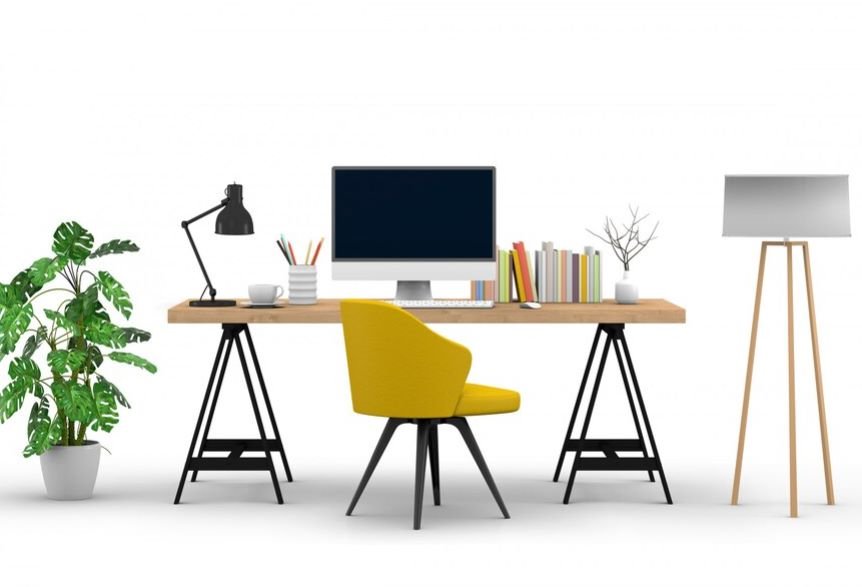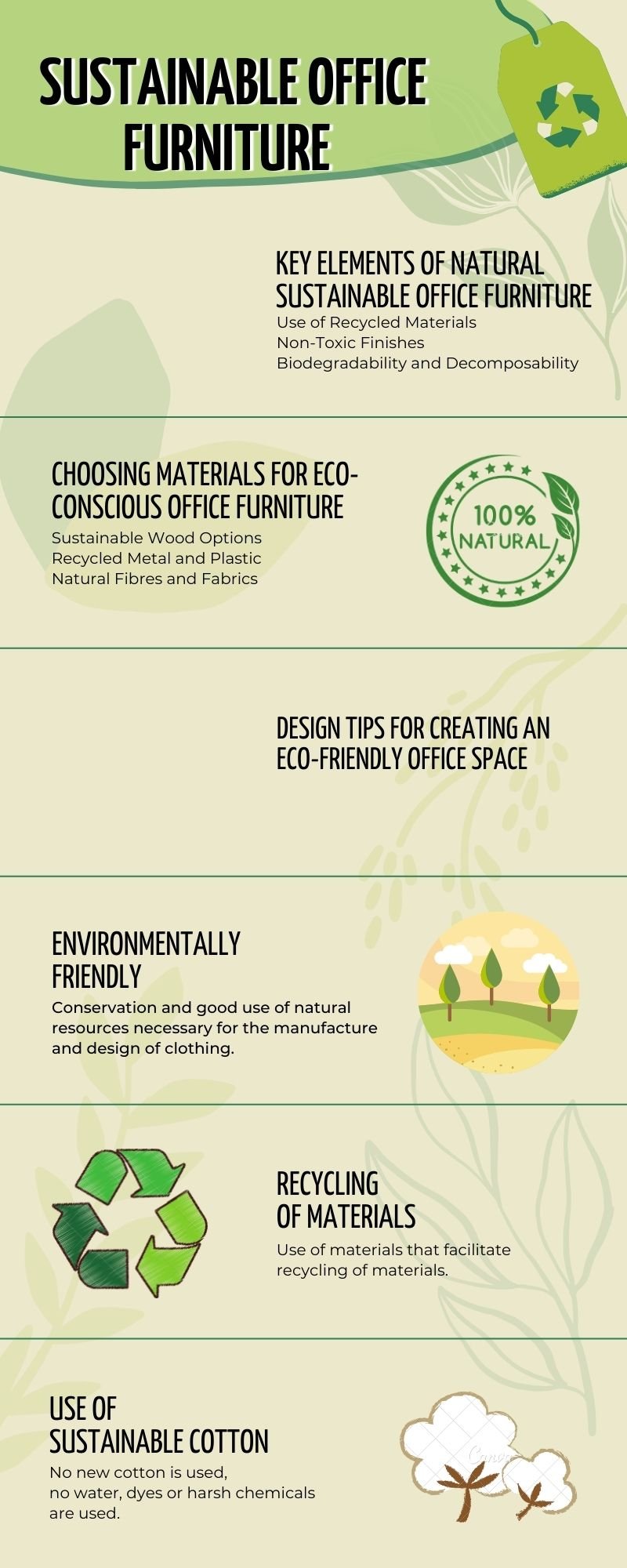Natural Sustainable Office Furniture With Eco-Consciousness
This guide unveils the essence of natural sustainable office furniture. It's more than just furniture; it's a commitment to environmental responsibility and employee well-being.
We'll delve into the core principles, like using natural, renewable, or recycled materials (think FSC-certified wood and organic fabrics) and prioritizing furniture built to last. Discover how to create a calming and productive atmosphere with nature's palette of earthy hues and biophilic design elements like indoor plants.
We'll explore the art of sustainable sourcing, from supporting local artisans to finding secondhand gems. You'll learn how furniture design can embrace functionality with clean lines, and space-saving pieces, and even draw inspiration from nature through biomimicry.
We'll shed light on sustainable illumination, maximizing natural light, and incorporating energy-efficient solutions. Finally, we'll show you how to accessorize with nature's touches, incorporating greenery, organic textures, and nature-inspired art.
This journey doesn't stop at furniture. Maintaining your eco-haven involves using eco-friendly cleaning products and promoting sustainable practices throughout the office.

What is Natural Sustainable Office Furniture with Eco-Consciousness?

Natural sustainable office furniture goes beyond aesthetics and functionality. It prioritises the environment and employee well-being throughout its lifecycle. This involves
Minimising environmental impact: This considers the materials used, production methods, and responsible disposal of furniture at the end of its lifespan. Sustainable furniture aims to reduce its carbon footprint and promote resource conservation.
Prioritising natural, renewable, or recycled materials: Sustainable furniture utilizes materials like FSC-certified wood, recycled plastic, or fast-growing renewable resources like bamboo. This reduces reliance on virgin materials and promotes a circular economy.
Promoting employee well-being: Sustainable design principles often incorporate ergonomics, natural materials, and features that enhance indoor air quality. This creates a healthier and more comfortable workspace for employees.
Key Elements of Natural Sustainable Office Furniture
Creating a sustainable office environment involves careful consideration of various factors, including the materials used in the furniture. Natural sustainable office furniture prioritises eco-friendly materials and production processes, incorporating key elements that contribute to environmental conservation and employee well-being.
Use of Recycled Materials
One essential element of natural sustainable office furniture is the utilization of recycled materials. By repurposing materials such as reclaimed wood, recycled metal, or recycled plastic, furniture manufacturers minimize the demand for virgin resources and reduce waste.
Recycled materials not only conserve natural resources but also divert waste from landfills, promoting a circular economy. Furniture crafted from recycled materials maintains quality and durability while significantly reducing its environmental footprint.
Non-Toxic Finishes
Another crucial aspect of natural sustainable office furniture is the use of non-toxic finishes. Conventional furniture often contains finishes and coatings that emit harmful chemicals into the air, contributing to indoor air pollution and potential health hazards for occupants.
In contrast, sustainable furniture manufacturers prioritize the use of non-toxic, low-VOC (volatile organic compound) finishes. These finishes are free from harmful chemicals such as formaldehyde and phthalates, ensuring a healthier indoor environment for employees.


Biodegradability and Decomposability
The biodegradability and decomposability of office furniture are essential considerations for sustainability. Natural sustainable furniture is designed to break down naturally at the end of its lifecycle, minimizing environmental impact and reducing landfill waste.
Materials such as bamboo, cork, and certain types of wood are biodegradable and can decompose over time without releasing harmful pollutants. Additionally, furniture components such as upholstery fabrics and cushioning materials can be chosen for their biodegradable properties, further enhancing sustainability efforts.
Choosing Materials for Eco-conscious Office Furniture
Selecting the right materials is crucial when it comes to creating eco-conscious office furniture. By opting for sustainable and environmentally friendly materials, businesses can minimise their environmental impact and contribute to a greener future.
Sustainable Wood Options
Wood is a commonly used material in office furniture, but not all wood is sourced sustainably. Choosing sustainable wood options such as FSC-certified (Forest Stewardship Council) or reclaimed wood helps to ensure responsible forest management practices. These woods are harvested in a manner that maintains forest health, biodiversity, and the rights of indigenous peoples.
Recycled Metal and Plastic
Incorporating recycled metal and plastic into office furniture is another effective way to reduce environmental impact. Recycled metals, such as aluminum and steel, can be melted down and repurposed into new furniture components, conserving energy and resources in the process. Similarly, recycled plastics can be used to create durable and long-lasting furniture pieces, diverting plastic waste from landfills and oceans.
Natural Fibres and Fabrics
When it comes to upholstery and textiles, choosing natural fibers and fabrics can significantly enhance the eco-friendliness of office furniture. Materials such as organic cotton, hemp, and linen are grown without the use of harmful pesticides and synthetic fertilizers, reducing environmental pollution and promoting soil health. Additionally, natural fabrics are biodegradable and have a lower carbon footprint compared to synthetic alternatives.
Stone and Concrete: Earthy Strength and Elegance: Recycled content concrete offers a sustainable alternative with a touch of modern sophistication.
Rattan, Bamboo, and Wicker: Textural Delights: These fast-growing and renewable resources add warmth and visual interest while being environmentally friendly.
Design Tips for Creating an Eco-friendly Office Space
Designing an eco-friendly office space goes beyond furniture selection; it involves thoughtful consideration of the overall design elements to minimise environmental impact while promoting a healthy and sustainable workplace environment.
Maximizing Natural Light and Ventilation
Maximizing natural light and ventilation is a cornerstone of eco-friendly office design. By strategically placing windows and skylights, offices can harness natural daylight to illuminate the workspace, reducing the need for artificial lighting and lowering energy consumption. Additionally, proper ventilation design allows for the efficient circulation of fresh air, improving indoor air quality and reducing the reliance on mechanical ventilation systems.
Incorporating Indoor Plants
Incorporating indoor plants into office spaces is not only aesthetically pleasing but also beneficial for environmental sustainability and employee well-being. Plants help to purify the air by absorbing harmful pollutants and releasing oxygen, creating a healthier indoor environment. Furthermore, indoor plants can contribute to biophilic design principles, connecting occupants with nature and reducing stress levels.
Minimalistic Design Approach
Embracing a minimalistic design approach is key to creating an eco-friendly office space that prioritises simplicity and functionality. Minimalistic design focuses on decluttering and streamlining the workspace, reducing the need for excessive furniture and materials. By opting for minimalist furniture designs and eliminating unnecessary decorations, offices can minimise waste and promote a clean and organised environment.
Incorporating Sustainability into Office Furniture Purchases
When it comes to furnishing an office space, incorporating sustainability into furniture purchases is essential for businesses committed to reducing their environmental footprint. By considering various factors such as company sustainability practices, certifications and labels, and the longevity and durability of furniture pieces, businesses can make informed decisions that align with their sustainability goals.


Researching Company Sustainability Practices
Before making office furniture purchases, it’s crucial to research the sustainability practices of furniture manufacturers and suppliers. Look for companies that prioritize sustainability throughout their supply chain, from sourcing materials to manufacturing processes and transportation methods. By choosing vendors with transparent sustainability practices, businesses can ensure that their furniture purchases support environmentally responsible companies.
Considering Certifications and Labels
When selecting office furniture, look for certifications and labels that indicate environmental and ethical standards. Certifications such as Forest Stewardship Council (FSC) for wood products, Global Organic Textile Standard (GOTS) for textiles, and Cradle to Cradle (C2C) for overall product sustainability provide assurance that the furniture meets specific environmental criteria. By choosing certified furniture, businesses can be confident in their commitment to sustainability and responsible sourcing.
Longevity and Durability of Furniture Pieces
Investing in office furniture with longevity and durability in mind is key to reducing environmental impact and minimising waste. Choose high-quality furniture made from durable materials that are built to last, rather than opting for cheap, disposable options. By selecting furniture pieces that withstand the test of time, businesses can minimise the need for frequent replacements and reduce overall resource consumption.
Eco-friendly Brands Leading the Way in Office Furniture
As sustainability becomes increasingly important in the corporate world, many furniture brands are stepping up to the challenge by incorporating eco-friendly practices into their operations. Here, we highlight some of the leading brands that are paving the way for sustainability in office furniture.
Brand Spotlight: Herman Miller’s Environmental Initiatives
Herman Miller is renowned for its commitment to environmental sustainability, with a range of initiatives aimed at reducing its environmental footprint. From sourcing sustainable materials to implementing energy-efficient manufacturing processes, Herman Miller prioritises environmental responsibility throughout its operations.
Sustainable Innovations by Steelcase
Steelcase is another industry leader known for its sustainable innovations in office furniture. The company focuses on designing products that minimize environmental impact while maximizing functionality and comfort. From incorporating recycled materials into its furniture to optimizing packaging for minimal waste, Steelcase continues to push the boundaries of sustainability in the furniture industry.
Green Practices of Knoll Inc.
Knoll Inc. is dedicated to integrating green practices into its business model, with a focus on sustainable design and manufacturing. The company utilizes environmentally friendly materials and production methods to create high-quality, durable furniture that meets the highest standards of sustainability. Knoll Inc.’s commitment to environmental stewardship has earned it recognition as a leader in eco-friendly office furniture.
Emerging Eco-conscious Office Furniture Brands
In addition to established industry players, there is a growing number of emerging eco-conscious office furniture brands making waves in the market. These brands prioritise sustainability in their design, production, and distribution processes, offering innovative solutions for businesses looking to furnish their offices with minimal environmental impact.
Benefits of Ethical Eco-Friendly Office Furniture
In today’s environmentally conscious world, the choice of office furniture extends beyond mere functionality and aesthetics. Ethical eco-friendly office furniture offers a myriad of benefits that not only enhance the working environment but also contribute positively to global sustainability efforts.


Health Benefits of Natural Materials
When selecting office furniture made from natural materials such as wood, bamboo, or organic fabrics, one can significantly reduce exposure to harmful chemicals commonly found in conventional furniture. These natural materials are often free from volatile organic compounds (VOCs) and other toxins, promoting better indoor air quality and reducing the risk of respiratory issues and allergies among office occupants.
Additionally, natural materials tend to be more breathable and comfortable, providing a healthier and more enjoyable workspace for employees. By prioritising the use of natural materials in office furniture, companies can foster a workplace environment that prioritises employee well-being and productivity.
Reduced Environmental Impact
One of the most significant advantages of ethical eco-friendly office furniture is its reduced environmental impact compared to conventional counterparts. Sustainable office furniture is typically crafted from renewable or recycled materials, minimizing the depletion of natural resources and reducing waste.
By opting for eco-friendly office furniture, companies can significantly decrease their carbon footprint and contribute to the preservation of ecosystems. Furthermore, many eco-conscious furniture manufacturers employ sustainable production. practices, such as energy-efficient manufacturing processes and minimal packaging, further mitigating environmental harm.
Corporate Social Responsibility
Investing in ethical eco-friendly office furniture is not only beneficial for the environment and employee health but also reflects a company’s commitment to corporate social responsibility (CSR). By choosing sustainable furniture options, businesses demonstrate their dedication to ethical business practices and sustainability initiatives.
Corporate social responsibility encompasses various aspects, including environmental stewardship, ethical labor practices, and community engagement. Choosing eco-friendly office furniture aligns with these principles by supporting environmentally responsible suppliers and promoting sustainable consumption patterns.
Maintaining Your Natural Sustainable Office Haven
Maintaining the eco-friendly nature of your workspace goes beyond the initial furniture choices. Here are some practices to consider
Eco-Friendly Cleaning Products for Sustainable Maintenance: Opt for non-toxic and biodegradable cleaning products that are safe for both your employees and the environment.
Sustainable Practices for Daily Living: Encourage energy-saving habits like switching off lights and electronics when not in use, using reusable mugs and water bottles, and promoting proper recycling practices throughout the office.
FAQs: Sustainable Office Furniture
What is natural sustainable office furniture?
Natural sustainable office furniture prioritises both environmental and human well-being. It utilises natural, renewable, or recycled materials, minimises environmental impact throughout its lifecycle, and promotes employee health through ergonomics and healthy materials.
What are the benefits of sustainable office furniture?
Reduces environmental impact through material selection, production methods, and responsible disposal.
Creates a healthier work environment with natural materials and improved air quality.
Enhances employee well-being with ergonomic design and a connection to nature.
Can potentially lower energy consumption with natural light optimization and energy-efficient lighting.
What are some sustainable materials for office furniture?
Wood (FSC-certified)
Stone and recycled content concrete
Rattan, bamboo, and wicker
Organic fabrics like linen, cotton, and wool
How can I source sustainable office furniture eco-consciously?
Support local artisans and sustainable businesses.
Consider secondhand or upcycled furniture.
Look for certifications like FSC wood and organic textiles.
What are some sustainable practices for maintaining an eco-friendly office?
Use eco-friendly cleaning products.
Encourage energy-saving habits like turning off lights and electronics when not in use.
Promote recycling and responsible waste management.
Utilise natural light and incorporate plants for air purification.
Infographic Of Natural Sustainable Office Furniture




